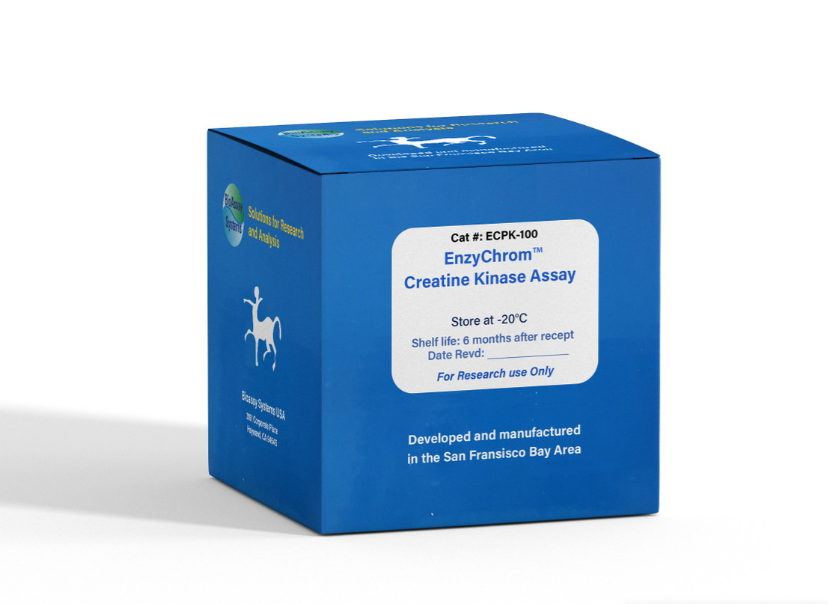DESCRIPTION
CREATINE KINASE (CK), also known as creatine phosphokinase (CPK), is an enzyme (EC 2.7.3.2) expressed predominantly in skeletal muscle, smooth muscle and the brain. The CK enzyme consists of two subunits, which can be either B (brain type) or M (muscle type), and hence three different isoenzymes: CK-MM, CK-BB and CK-MB. CK catalyzes the conversion of creatine to phosphocreatine, consuming adenosine triphosphate (ATP) and generating adenosine diphosphate (ADP) and the reverse reaction. CK is often determined routinely in emergency patients with chest pain and acute renal failure. Elevation of CK is an indication of damage to muscle and has been associated with injury, rhabdomyolysis, myocardial infarction, myositis, myocarditis, malignant hyperthermia and neuroleptic malignant syndrome, etc. Lower levels can be an indication of alcoholic liver disease and rheumatoid arthritis.
Simple, direct and automation-ready procedures for measuring CK activity are very desirable. BioAssay Systems' EnzyChromTM Creatine Kinase Assay Kit is based on enzyme coupled reactions in which creatine phosphate and ADP is converted to creatine and ATP by CK, the generated ATP is used to phosphorylate glucose by hexokinase to generate glucose-6-phosphate, which is then oxidized by NADP in the presence of glucose-6-phosphate dehydrogenase. The produced NADPH, measured at 340 nm, is proportionate to the CK activity in the sample.
APPLICATIONS
Direct Assays: CK in serum, plasma and other biological samples.
Pharmacology: effects of drugs on CK activity.
KEY FEATURES
Sensitive and accurate. Detection range: 5 to 300 U/L creatine kinase in 96-well plate assay.
Convenient. The procedure involves adding a single working reagent, and reading the optical density at 20 min and 40 min at room temperature or 37°C.
High-throughput. Can be readily automated as a high-throughput 96- well plate assay for thousands of samples per day.
KIT CONTENTS (100 tests in 96-well plates)
Assay Buffer: 12 mL Substrate Solution: 1.0 mL
Enzyme Mix: 120 µL Calibrator: 150 µL
Storage conditions. This kit is shipped on ice. Store all reagents at - 20°C. Shelf life: 6 months after receipt.
Precautions: reagents are for research use only. Normal precautions for laboratory reagents should be exercised while using the reagents. Please refer to Material Safety Data Sheet for detailed information.
PROCEDURES
Sample Preparation. Use non-hemolyzed samples. Samples should be assayed within 4 hours of blood collection if they remain at room temperature, or within 12 hours if stored at 4°C. Samples can be stored at -80°C and should be thawed only once. If turbidity is observed, centrifuge sample and use clear supernatant for assay. Reagent Reconstitution. Bring all components to room temperature. For each reaction well, mix 10 µL Substrate Solution, 100 µL Assay Buffer and 1 µL Enzyme Mix. Fresh reconstitution is recommended. If the assay is to be carried out at 37°C, warm up the Reconstituted Reagent at 37°C.
1. Calibrator: transfer 110 µL water and (10 µL Calibrator + 100 µL water) into separate wells of a clear bottom 96-well plate. Samples: transfer 10 µL samples into separate wells. Add 100 µL Reconstituted Reagent and tap plate to mix
2. Reaction. Incubate at room temperature or 37°C. CK is fully activated within 20 min by glutathione provided in the Substrate Solution. Read OD340nm at 20 min and again at 40 min.
3. Calculation. Calculate sample CK activity using the equation,
OD40min and OD20min are OD340nm values at 40 min and 20 min for the sample. ODCALIBRATOR and ODH2O are OD340nm values of the Calibrator and water blank at 40 min. The value 150 is the equivalent activity (U/L) of the Calibrator under the assay conditions. Unit definition: one unit of CK will transfer 1 µmole of phosphate from phosphocreatine to ADP per min at pH 6.0.
Note: If the CK activity is expected to be higher than 300 U/L, read OD340nm at 20 min and again at 25 min. To calculate the CK activity replace (OD40min – OD20min) with (OD25min – OD20min) and replace the factor 150 with 600 in the above equation. Linear range: 30 to 1,800 U/L CK activity.
MATERIALS REQUIRED, BUT NOT PROVIDED
Pipeting (multi-channel) devices. Clear-bottom 96-well plates (e.g. Corning Costar) and plate reader.
GENERAL CONSIDERATIONS
This assay is based on an enzyme-catalyzed kinetic reaction. Addition of Reconstituted Reagent should be quick and mixing should be brief but thorough. Use of multi-channel pipettor is recommended.
EXAMPLES
Samples were assayed in duplicate using the 96-well protocol. The CK activity (U/L) was 12.0 ± 0.9 for a rat serum sample, 11.0 ± 0.5 for human serum, 28 ± 1 for human plasma, 9.0 ± 0.8 for mouse serum and 49 ± 2 for bovine serum.
PUBLICATIONS
1. Itaka K et al (2010). Polyplex nanomicelle promotes hydrodynamic gene introduction to skeletal muscle. J Control Release. 143(1):112-9.
2. Steen C et al (2010). Reduced Creatine Kinase B Activity in Multiple Sclerosis Normal Appearing White Matter. PLoS One 5(5):e10811.
3. Kwon S et al. (2010). ASB9 interacts with ubiquitous mitochondrial
creatine kinase and inhibits mitochondrial function. BMC Biol. 8:23.
